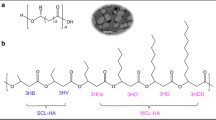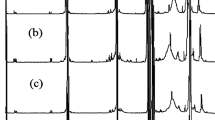Abstract
A family of promising polyhydroxyalkanoate(PHA) polyesters called Nodax™ class PHA copolymers, consisting of (R)-3-hydroxyalkanoate comonomer units with medium-size-chain side groups and (R)-3-hydroxybutyrate, are described. The bio-based biodegradable plastics made from renewable resources will be commercially available from Meredian. Because of the unique design of the molecular structure, the Nodax™ class PHA copolymers have a set of useful attributes, including polyolefin-like thermomechanical properties, polyester-like physicochemical properties, and interesting biological properties. Therefore, broad ranges of industrial and consumer product applications are anticipated. The structure and properties of the new PHA copolymers, as well as processing and conversion to various products are reviewed with some historical background of the development and future commercialization plans.
Access this chapter
Tax calculation will be finalised at checkout
Purchases are for personal use only
Similar content being viewed by others
References
Abe H, Doi Y, Fukushima T, Eya H (1994) Biosynthesis from gluconate of a random copolyester consisting of 3-hydroxybutyrate and medium-chain-length 3-hydroxyalkanoates by Psedomonas sp. 61–3. Int J Biol Macromol 16:115–119
Brandl H, Knee EJ, Fuller RC, Gross RA, Lenz RW (1989) Ability of the phototrophic bacterium Rhodosprillum rubrum to produce various poly(β-hydroxyalkanoates): potential sources for biodegradable polyesters. Int J Biol Macromol 11:49–55
Caballero KP, Karel SF, Register RA (1995) Biosynthesis and characterization of hydroxybutyrate-hydroxycaproate copolymers. Int J Biol Macromol 17:86–92
Chen GQ, Zhang G, Park SJ, Lee SY (2001) Industrial scale production of poly(3-hydroxybutyrate-co-3-hydroxyhexanoate). Appl Microbiol Biotechnol 57:50–55
Doi Y (1990) Microbial polyesters. VCH, New York
Federle TW, Barlaz MA, Pettigrew CA, Kerr KM, Kemper JJ, Nuck BA, Schechtman LA (2002) Anaerobic biodegradation of aliphatic polyesters: poly(3-hydroxybutyrate-co-3-hydroxyoctanoate) and poly(ε-caprolactone). Biomacromolecules 3:813–822
Huisman G, Leeuw O, Eggink G, Witholt B (1989) Synthesis of poly-3-hydroxyalkanoate is a common feature of fluorescent Pseudomonads. Appl Environ Microbiol 55:1949–1954
Kato M, Bao HJ, Kang CK, Fukui T, Doi Y (1996) Production of a novel copolyester of 3-hydroxybutyric acid and medium-chain-length 3-alkanoic acids by Psedomonas sp. 61–3 from sugars. Appl Microbiol Biotechnol 45:363–370
Lee SH, Oh DH, Ahn WS, Lee Y, Choi J, Lee SY (2000) Production of poly(3-hydroxybutyrate-co-3-hydroxyhexanaote) by high-cell-density cultivation of Aeromonas hydrophila. Biotechnol Bioeng 67:240–244
Marchessault RH, Monasterios CJ, Morin FG, Sundarajan PR (1990) Chiral poly(b-hydroxyalkanoates): an adaptable helix influenced by the alkane side-chain. Int J Biol Macromol 12:158–165
Melik DH, Noda I (2004) polymer products comprising soft and elastic biodegradable polyhydroxyalkanoate copolymer compositions and methods of preparing such polymer products. US Patent 6,794,023 B1
Noda (1996) Biodegradable copolymers and plastic articles comprising biodegradable copolymers. US Patent 5,498,692
Noda (1999) Films and absorbent articles comprising a biodegradable polyhydroxyalkanoate comprising 3-hydroxybutyrate and 3-hydroxyhexanoate comonomer units. US Patent 5,990,271
Noda I (2005) Plastic articles digestible by hot alkaline treatment. US Patent 6,872,802 B2
Noda I, Schechtman LA (1999) Solvent extraction of polyhydroxyalkanoates from biomass. US Patent 5,942,597
Noda I, Satkowski MM, Dowrey AE, Marcott C (2004) Polymer alloy of Nodax copolymers and poly(lactic acid). Macromol Biosci 4:269–275
Noda I, Bond EB, Green PR, Melik DH, Narasimhan K, Schechtman LA, Satkowski MM (2005a) Preparation, properties, and utilization of biobased biodegradable Nodax™ copolymers. In: Cheng HN, Gross RA (eds) Polymer biocatalysis and biomaterials. American Chemical Society, Washington, pp 280–291
Noda I, Green PR, Satkowski MM, Schechtman LA (2005b) Preparation and properties of a novel class of polyhydroxyalkanoate copolymers. Biomacromolecules 6:580–586
Poirier Y, Schechtman SC, LA SMM, Noda I (1995) Synthesis of high-molecular-weight poly([R]-(–)-3-hydroxybutyrate) in transgenic Arabidopsis thaliana plant cells. Int J Biol Macromol 17:7–12
Poliakoff M, Noda I (2004) Plastic bags, sugar cane and advanced vibrational spectroscopy: taking green chemistry to the third world. Green Chem 6:G37–G38
Satkowski MM, Melik DH, Autran J-P, Green PR, Noda I, Schechtman LA (2001) Physical and processing properties of polyhydroxyalkanoate copolymers. In: Doi Y, Steinbüchel A (eds) Polyesters II – properties and chemical synthesis, vol 3b, Biopolymers. Wiley, Weinheim, pp 231–263
Schechtman LA, Kemper JJ (1997) Polymerization of beta-substituted beta-propiolactones initiated by alkylzinc alkoxide. US Patent 5,648,452
Shiotani T, Kobayashi G (1994) Copolymer and method for producing thereof. US Patent 5,292,860
Steinbüchel A (1995) Diversity of bacterial polyhydroxyalkanoic acids. FEMS Microbiol Lett 128:219–228
Timm A, Steinbüchel A (1990) Formation of polyesters consisting of medium-chain-length 3-hydroxyalkanoic acids from gluconate by Pseudonomas aeruginosa and other fluorescent pseudomonads. Appl Environ Microbiol 56:3360–3367
Timm A, Byrom D, Steinbüchel A (1990) Formation of blends of various poly(3-hydroxyalkanoic acids) by a recombinant strain of Pseudomonas oleovorans. Appl Microbiol Biotechnol 33:296–301
Author information
Authors and Affiliations
Corresponding author
Editor information
Editors and Affiliations
Rights and permissions
Copyright information
© 2010 Springer-Verlag Berlin Heidelberg
About this chapter
Cite this chapter
Noda, I., Lindsey, S.B., Caraway, D. (2010). Nodax™ Class PHA Copolymers: Their Properties and Applications. In: Chen, GQ. (eds) Plastics from Bacteria. Microbiology Monographs, vol 14. Springer, Berlin, Heidelberg. https://doi.org/10.1007/978-3-642-03287-5_10
Download citation
DOI: https://doi.org/10.1007/978-3-642-03287-5_10
Published:
Publisher Name: Springer, Berlin, Heidelberg
Print ISBN: 978-3-642-03286-8
Online ISBN: 978-3-642-03287-5
eBook Packages: Biomedical and Life SciencesBiomedical and Life Sciences (R0)




